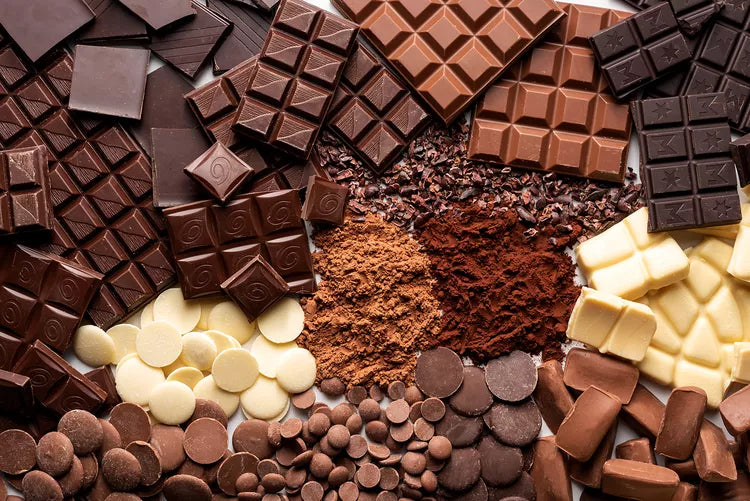
Heartburn from Chocolate: Why It Happens and How to Cope
|
|
Time to read 4 min
|
|
Time to read 4 min
Although chocolate is widely enjoyed, it is a common trigger for heartburn and acid reflux. This article explores the reasons chocolate can affect digestion, how it contributes to reflux symptoms, and practical strategies to reduce discomfort.
Disclaimer: The information provided in this blog post is for general knowledge and informational purposes only, and does not constitute medical advice. Always consult with a qualified healthcare professional before making any decisions about your health or treatment. If you experience persistent or severe acid reflux, seek medical attention immediately.
Heartburn occurs when acid from the stomach flows backward into the esophagus, leading to burning or discomfort in the chest or throat. Chocolate, though not acidic itself, has several properties that make it one of the more frequent dietary triggers of acid reflux, particularly in individuals with reflux-prone physiology.
The lower esophageal sphincter is a muscular ring that separates the stomach from the esophagus. Its function is to keep stomach contents from flowing backward. Certain compounds in chocolate - particularly methylxanthines like theobromine and caffeine - can relax the LES. When this barrier weakens, it increases the likelihood of reflux and the sensation of heartburn.
Highly sweetened chocolate products may promote bloating and fermentation in the gut, which increases abdominal pressure. Additionally, excessive sugar intake can disrupt the balance of gut microbiota and alter gastrointestinal motility, potentially exacerbating acid reflux symptoms in some individuals.
Even small amounts of caffeine and theobromine can stimulate acid production and further relax the LES. While chocolate contains less caffeine than coffee or tea, the combination of stimulants may still provoke symptoms in sensitive individuals, especially when consumed with other reflux triggers.
Highly sweetened chocolate can increase heartburn by promoting gut bloating and fermentation, which raises abdominal pressure and encourages acid reflux. Excess sugar may also disrupt gut microbiota and motility, worsening symptoms. Combined with chocolate’s fat, caffeine, and theobromine that relax the lower esophageal sphincter, this amplifies the risk of heartburn, especially in sensitive individuals.
Before making any changes, discuss persistent symptoms or severe discomfort with your prescribing healthcare provider. Adjustments to dosage, timing, or alternative therapy may be appropriate.
Not all chocolate is created equal when it comes to digestive comfort. While many people find that chocolate can be a heartburn trigger, the risk level often depends on the type of chocolate and its specific ingredients. Here is a quick guide to help you choose a chocolate that may be easier on your stomach.
| Chocolate Type | Why It May Cause Heartburn | Heartburn Risk |
| Dark Chocolate | High levels of caffeine, theobromine, and fat relax the lower esophageal sphincter (LES). | High |
| Milk Chocolate | Contains sugar and dairy fat, which can slow digestion and relax the LES. | Medium |
| White Chocolate | No cocoa solids (minimal caffeine/theobromine) but high in sugar and dairy fat. | Medium |
| Unsweetened/Baking Chocolate | Highest concentration of cocoa solids, caffeine, and theobromine, leading to strong LES relaxation. | Very High |
| Vegan Chocolate | Varies widely; contains cocoa solids with caffeine and theobromine, but may be lower in fat and sugar depending on formulation. | Variable (depends on ingredients and cocoa %) |
Eating chocolate close to bedtime increases the risk of nocturnal acid reflux because lying down reduces the effect of gravity on digestion. To minimize this risk, it is advisable to consume chocolate at least two to three hours before sleeping.
If you’re unsure whether chocolate is a personal trigger, consider keeping a food and symptom journal for one to two weeks. Note the type of chocolate, portion size, and when symptoms occur. This can help determine if chocolate is a consistent factor or if symptoms may be due to other variables.
Ready to take an extra step? You can take Claisen’s free quiz for personalized insights into your gut health.
Combining chocolate with low-fat, non-acidic foods may help mitigate its potential to trigger heartburn. For instance, pairing a small piece of dark chocolate with oatmeal or a banana can help buffer its effects and reduce the likelihood of discomfort.
Chocolate may trigger acid reflux by relaxing the LES, delaying digestion, and stimulating acid production.
Dark chocolate typically contains more reflux-inducing compounds, but milk chocolate may still cause symptoms due to fat and sugar content.
Avoid common dietary triggers and consider sleep modifications if reflux occurs at night.
Reducing portion size, avoiding late-night consumption, and pairing chocolate with low-fat foods may improve tolerance.
If symptoms persist despite adjustments, it may be advisable to limit intake or consult a healthcare provider.
Ready for personalized relief for acid reflux? Complete Claisen's gut health quiz to identify your unique reflux triggers and receive evidence-based recommendations tailored to your digestive profile.
This article and its contents have been medically reviewed by Aditya Jain (MD at Harvard Medical School and Op-Ed Fellow at Doximity).
Not necessarily. Some individuals can tolerate small amounts without symptoms. The key factors are portion size, timing, and individual sensitivity.
White chocolate contains little to no cocoa, caffeine, or theobromine, but it is high in sugar and fat. While it may be slightly less triggering, it’s not always reflux-safe.
Occasionally using antacids may provide temporary relief, but long-term management is best achieved through dietary modifications and lifestyle changes.

